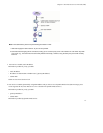Chapter 4. Your Internet Service Provider (ISP)
4.2.1. Static versus dynamic IP addressing
A static IP address never changes. It is permanently assigned to your server by your ISP.
Note: Static IP addressing is preferable to dynamic IP addressing because it makes it easier for users on the Internet to connect to
your services.
Dynamic IP address assignment means that your IP address is assigned to you only temporarily and may be changed by your ISP.
This makes it more difficult to ensure continuity of service to your network. Consider again our telephone number analogy. When
your telephone number changes, you are able to place outgoing calls. However, until your new phone number is registered with
Directory Services, other people are unable to look up your new number and place calls to you. Similarly, whenever your IP address
changes, a record associating your server with its new IP address must be published with the equivalent of Directory Services
(known as Domain Name Service or DNS) before incoming traffic can find you.
If your IP address is dynamically assigned and you have a dedicated connection to your ISP (for example, with a typical
cablemodem), you may find it helpful to use a dynamic DNS service. We strongly recommend you review Appendix B: Dynamic
DNS services for more information about this worthwhile option.
4.2.2. Routable versus non-routable IP addresses
If an IP address is analogous to your phone number, then a routable IP address is the equivalent of a full telephone number complete
with country code and area code such as +1-613-555-1234. Using the same analogy, a non-routable address is the equivalent of an
office extension. If your server is assigned a non-routable address, it cannot directly receive incoming Internet connections, which
limits the services that it can provide to your site.
4.3. Arranging connectivity with your ISP
If you are going to be using your server in "server and gateway" mode, you will need to arrange for a connection to the Internet. Your
ISP will help you connect your site and provide you with services that enable you to take advantage of the Internet (e.g. e-mail
delivery). To some extent, the type of connection used determines the services needed. Therefore, we guide you first through
arranging connectivity and then direct you to the appropriate list of services for each type of connection. The terms used in the
following sections are defined at the end of this chapter.
To connect your site to the Internet, you not only need to arrange your physical connection (modem, DSL, etc.), but you also need to
ensure that your server can locate the appropriate devices at your ISP’s site. Your ISP will give you this information (e.g. IP
addresses for their devices) which must eventually be entered into your server console (a straightforward process covered in a later
chapter). Many ISPs use a DHCP server which can directly configure your server with some or all of these parameters.
4.3.1. Ordering a corporate ADSL or other commercial dedicated connection
Typically, your ISP will arrange for and configure your external hub and router. Alternatively, you may be required to install that
hardware yourself under their direction. If a special phone line is required, the ISP will typically arrange that. It is most typical with
15


















